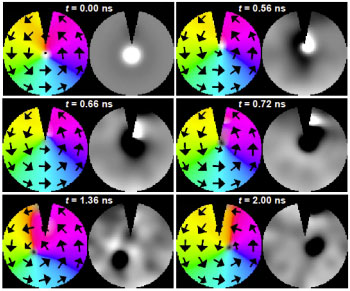| Posted: Dec 24, 2014 |
Magnetic vortices: Controlling core switching in Pac-man disks
|
|
(Nanowerk News) Magnetic vortices in thin films can encode information in the perpendicular magnetization pointing up or down relative to the vortex core. These binary states could be useful for non-volatile data storage devices such as RAM memories, but the switching between them must be fast and energy-efficient. However, despite many efforts switching is still slow and requires very large currents.
|
|
Pac-man disks, whose shape resembles the retro arcade game, seem to be a promising approach and Yoshinobu Nakatani and co-workers from the University of Electro-Communications now show a more efficient way of controlling switching in these devices ("Control of magnetic vortex core switching in a Pac-man disk using a single current pulse").
|
|
To better understand the mechanisms and the best switching conditions in the Pac-man disks, Nakatani's team used micro-magnetic simulations to investigate vortex core switching driven by an in-plane nanosecond current pulse. The simulations uncovered several interesting features. They found that the notch - Pac-man's mouth - plays the double role of annihilating and nucleating the vortex core. The kinetic field induced by the core motion gives the direction of nucleation.
|
 |
| Prof. Nakatani team performed micro-magnetic simulations and took snapshots of the Pac-man disk (diameter = 200 nm, thickness = 40 nm) at different times (t = 0∼2.0 ns) .The rainbow images indicating the direction of the in-plane magnetization component, whereas the grayscale images show the out-of-plane magnetization (white,up; black,down). The vortex core switches from upward to downward.
|
|
These results suggest that "by utilizing both the core switching at the notch edge and the direction of the core motion, the core polarity can be uniquely controlled by adjusting the direction of the current pulse". In this way the current density could be reduced by 75% compared with that of a circular disk of the same diameter and thickness. The insights provided by Nakatani's team could lead to an improved design of vortex core memory cells.
|

